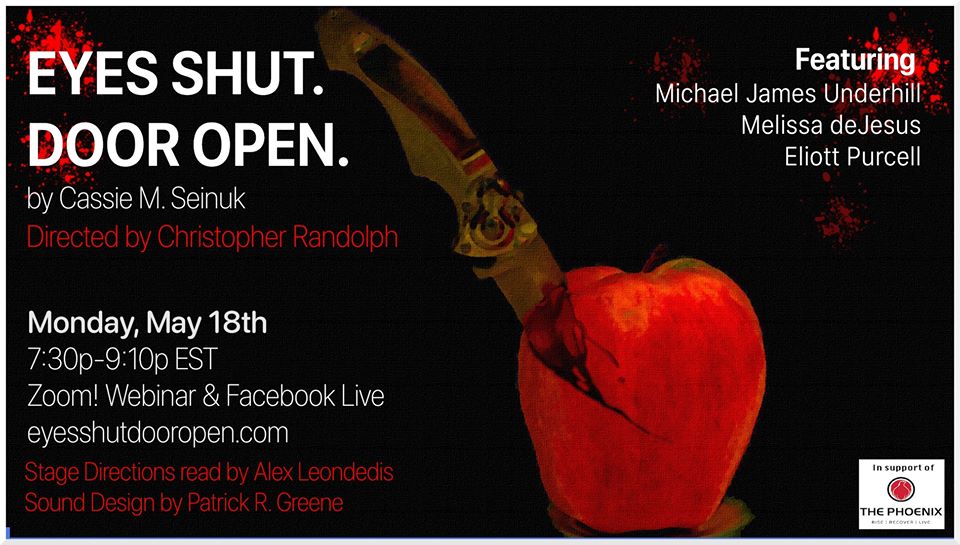
A virtual presentation over Zoom
May 18, 2020, 7:30PM
A fundraiser and awareness campaign for The Phoenix Sober Community
Please donate to the campaign HERE
Written by Cassie M. Seinuk
Directed by Christopher Randolph
Sound design by Patrick Greene
Turner played by Michael Underhill
Johanna played by Melissa deJesus
Palmer played by Eliott Purcell
Stage Directions by Alex Leondedis
Critique by Kitty Drexel
ZOOM — I reviewed Eyes Shut. Door Open. four years ago at Warehouse XI in Somerville, MA. This response to the May 18 reading does not supersede the 2016 critique. It exists in addition to it. It is critical to examine theatre’s adaptation to online performance.
One of the new rules of Zooming is to make your bed. If you insist on streaming from your bedroom, make your bed. Anyone watching you is already judging you on your household aesthetics (or lack thereof). Inviting viewers into your bedroom means sharing an intimate part of you. They will imagine you in that naughtily unmade bed. They will see your unwashed sheets and rumpled comforter and judge your hygiene. Better to make your bed than to feed the trolls. Never feed the trolls.
Speaking of rules. Necessity is forcing actors to develop new techniques for online streaming. Monday’s performance of Eyes Shut. Door Open revealed some mighty useful technical skills in its performers and sound technician. There was a lot to learn from this reading.
- Using the spacebar mute option: In Turner’s mad scenes: Underhill employed sleight of hand to manipulate the spacebar mute option while distracting his audience with the other. He’d gesture with his left hand and press with the right. That’s good performance technique. It implies that he and the crew were thoughtful about their sound design too. It takes this work above a mere reading and into virtuosic performance territory.
- Using the space between the actor and the camera to signify intimacy and character mental health: Eyes Shut. Door Open. has intimate scenes and mad scenes. The cast couldn’t rely on the camera to move so they moved their bodies instead. Underhill and deJesus moved closer to their camera to articulate to their unseen audience that things were heating up. Purcell moved closer to his camera as he frolicked into madness. All three moved away from the camera and therefore us as they sought distance from each other as well as the uncomfortable truths they learn in the play. Their movements were small but made big difference to the performance.
- Zoom still necessitates an intimacy director/choreographer: In Eyes Shut. Door Open. there is intimacy between the characters Johanna and Turner. At first, they used only their body language to signify increased intimacy. Then they inched closer to their cameras. But then both actors got too close. Their bedroom eyes, which would work well on a stage, were creepy over Zoom. Over Zoom, the audience quickly becomes the third wheel. Johanna and Turner were looking at each other… But they were also looking directly at us. No amount of actor’s intent can prevent a single, first-person perspective camera shot from interjecting the audience into the middle of a makeout scene. I’m no prude but I firmly believe in exuberant consent from all comers. Or, at the very least, presenter-controlled gallery view. Underhill and deJesus were working too hard for their intimate scenes to be so awkward.
- Violence is still violent. Abuse is still abuse: Eyes Shut. Door Open. examines the abusive relationships between brothers, and between an artist and an arts journalist. In the staged production, there are choreographed fight scenes. Monday’s reading proves that verbal fights through an intimate medium such as Zoom can be equally as effective as staged fisticuffs if not more so. The emotional punch is all there on the screen. The intensity is strengthened, not inhibited if one’s actors are up to the dramatic challenge.
- Stage Directions are as much of the play as the dialogue: Alex Leondedis was as involved in the production as Underhill, deJesus and Purcell. He was invisible but just as present as the Sandman. He was intimate with Johanna and Turner. He went mad with Palmer. Without Leondedis, the audience would have missed nearly all of the play’s action. We needed Leondedis to fuel our imagination. A play without stage directions is a mildly interesting cell phone call that no one needs to hear.
- Zoom Readings Can Be as Engrossing as Live Performance: The performance at Warehouse XI was good and this one was good too. There are some pluses to Zoom. I was pulled into the reading’s reality and its drama more readily. My feelings toward Turner, Johanna, and Palmer were more immediate. The work of Underhill, deJesus, Purcell and Leondedis was inescapable. It wasn’t a better performance. It was an equal performance. Calling it just a reading though is a disservice to the work cast and crew put into it.
- Zoom Sound Design is Magic: I don’t know how Patrick Greene managed his sound design but it was magical. Was he simultaneously in all the actors’ houses as the performance ran? I don’t know. Possibly.
The pandemic is reinventing theatre. It behooves us to learn as much as we can while we can. If you missed Monday’s performance, that’s too bad. It was super cool. Try to catch the next one. And DONATE.
